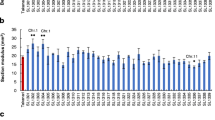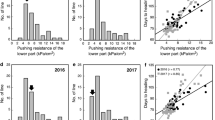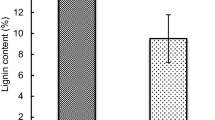Abstract
Bending-type lodging is one of the most important factors affecting the yield and grain quality of rice. This study identified quantitative trait loci (QTLs) for physical strength of the upper culms, and evaluated QTL effects on lodging resistance. In 2010 and 2011, QTLs for breaking strength, length, and diameter of the top three internodes were identified by analyzing chromosomal segment substitution lines (CSSLs) developed from ‘Koshihikari’ and ‘Kasalath’. The QTL analysis indicated that ‘Kasalath’ had two types of QTLs: one to strengthen specific internodes and one to simultaneously improve the physical strengths of plural internodes or the top three internodes. A QTL for breaking strengths of the top three internodes (bsuc11) was detected on chromosome 11 in both years. This QTL did not overlap with that for internode length. To evaluate the effects of bsuc11 on lodging resistance, this study selected three CSSLs with bsuc11 and analyzed the breaking strengths of the top three internodes after heading and the pushing resistance of the lower part. Internodes of ‘Koshihikari’ showed decreased breaking strengths after grain filling, while those of CSSLs with bsuc11 did not show this decrease in breaking strength. The pushing resistance of the lower part at the fully ripe stage was the same in ‘Koshihikari’ and CSSLs with bsuc11. These results suggested that bsuc11 could be a target to improve the physical strength of the upper culms to resist bending-type lodging, and that the physical strengths of upper and lower parts are controlled by different genetic factors in rice.



Similar content being viewed by others
References
Atkins IM (1938) Relation of certain plant characters to strength of straw and lodging in winter wheat. J Agric Res 56:99–120
Berry PM, Spink J, Sterling M, Pickett AA (2003) Methods for rapidly measuring the lodging resistance of wheat cultivars. J Agron Crop Sci 189:390–401
Börner A, Korzun V, Malyshev S, Ivandic V, Graner A (1999) Molecular mapping of two dwarfing genes differing in their GA response on chromosome 2H of barley. Theor Appl Genet 99:670–675
Ebitani T, Takeuchi Y, Nonoue Y, Yamamoto T, Takeuchi K, Yano M (2005) Construction and evaluation of chromosome segment substitution lines carrying overlapping chromosome segment of indica rice cultivar “Kasalath” in a genetic background of japonica elite cultivar “Koshihikari”. Breed Sci 55:65–73
Fouéré A, Pellerin S, Duparque A (1995) A portable electronic device for evaluating root lodging resistance in maize. Agron J 87:1020–1024
Hong Z, Ueguchi-Tanaka M, Umemura K, Uozu S, Fujioka S, Takatsuto S, Yoshida S, Ashikari M, Kitano H, Matsuoka M (2003) A rice brassinosteroid-deficient mutant, ebisu dwarf (d2), is caused by a loss of function of a new member of cytochrome P450. Plant Cell 15:2900–2910
Idris MD, Hossain MM, Choudhury FA (1975) The effect of silicon on lodging of rice in presence of added nitrogen. Plant Soil 43:691–695
Ishimaru K, Togawa E, Ookawa T, Kashiwagi T, Madoka Y, Hirotsu N (2008) New target for rice lodging resistance and its effect in a typhoon. Planta 227:601–609
Ivandic V, Malyshev S, Korzun V, Graner A, Börner A (1999) Comparative mapping of a gibberellic acid-insensitive dwarfing gene (Dwf2) on chromosome 4HS in barley. Theor Appl Genet 98:728–731
Jones L, Ennos AR, Turner SR (2001) Cloning and characterization of irregular xylem4 (irx4): a severely lignin-deficient mutant of Arabidopsis. Plant J 26:205–216
Kashiwagi T, Ishimaru K (2004) Identification and functional analysis of a locus for improvement of lodging resistance in rice. Plant Physiol 134:676–683
Kashiwagi T, Madoka Y, Hirotsu N, Ishimaru K (2006) Locus prl5 improves lodging resistance of rice by delaying senescence and increasing carbohydrate reaccumulation. Plant Physiol Biochem 44:152–157
Kashiwagi T, Hirotsu N, Madoka Y, Ookawa T, Ishimaru K (2007) Improvement of resistance to bending-type lodging in rice. Jpn J Crop Sci 76:1–9
Kashiwagi T, Togawa E, Hirotsu N, Ishimaru K (2008) Improvement of lodging resistance with QTLs for stem diameter in rice (Oryza sativa L.). Theor Appl Genet 117:749–757
Keller M, Karutz Ch, Schmid JE, Stamp P, Winzeler M, Keller B, Messmer MM (1999) Quantitative trait loci for lodging resistance in a segregating wheat × spelt population. Theor Appl Genet 98:1171–1182
Khush GS (1999) Green revolution: preparing for the 21st century. Genome 42:646–655
Kokubo A, Kuraishi S, Sakurai N (1989) Culm strength of barley: correlation among maximum bending stress, cell wall dimensions, and cellulose content. Plant Physiol 91:876–882
Kokubo A, Sakurai N, Kuraishi S, Takeda K (1991) Culm brittleness of barley (Hordeum vulgare L.) mutants is caused by smaller number of cellulose molecules in cell wall. Plant Physiol 97:509–514
Kono M (1995) Physiological aspects of lodging. In: Matsuo T, Kumazawa K, Ishii R, Ishihara K, Hirata H (eds) Science of the rice plant, vol. 2: physiology, vol 2. Food and Agriculture Policy Research Center, Tokyo, pp 971–982
Lee SH, Bailey MA, Mian MAR, Shipe ER, Ashley DA, Parrott WA, Hussey RS, Boerma HR (1996) Identification of quantitative loci for plant height, lodging, and maturity in a soybean population segregating for growth habit. Theor Appl Genet 92:516–523
Li Y, Qian Q, Zhou Y, Yan M, Sun L, Zhang M, Fu Z, Wang Y, Han B, Pang X, Chen M, Li J (2003) BRITTLE CULM1, which encodes a COBRA-like protein, affects the mechanical properties of rice plants. Plant Cell 15:2020–2031
Madoka Y, Kashiwagi T, Hirotsu N, Ishimaru K (2008) Indian rice “Kasalath” contains genes that improve traits of Japanese premium rice “Koshihikari”. Theor Appl Genet 116:603–612
Mori M, Nomura T, Ooka H, Ishizaka M, Yokota T, Sugimoto K, Okabe K, Kajiwara H, Satoh K, Yamamoto K, Hirochika H, Kikuchi S (2002) Isolation and characterization of a rice dwarf mutant with a defect in brassinosteroid biosynthesis. Plant Physiol 130:1152–1161
Mulder EG (1954) Effect of mineral nutrition on lodging of cereals. Plant Soil 5:246–306
Ookawa T, Hobo T, Yano M, Murata K, Ando T, Miura H, Asano K, Ochiai Y, Ikeda M, Nishitani R, Ebitani T, Ozaki H, Angeles ER, Hirasawa T, Matsuoka M (2010) New approach for rice improvement using a pleiotropic QTL gene for lodging resistance and yield. Nat Commun 1:132
Peng S, Cassman K, Virmani SS, Sheehy J, Khush GS (1999a) Yield potential trends of tropical rice since the release of IR8 and the challenge of increasing rice yield potential. Crop Sci 39:1552–1559
Peng J, Richards DE, Hartley NM, Murphy GP, Devos KM, Flintham JE, Beales J, Fish LJ, Worland AJ, Pelica F, Sudhakar D, Christou P, Snape JW, Gale MD, Harberd NP (1999b) ‘Green revolution’ genes encode mutant gibberellin response modulators. Nature 400:256–261
Peng S, Khush GS, Virk P, Tang Q, Zou Y (2008) Progress in ideotype breeding to increase rice yield potential. Field Crop Res 108:32–38
Sasaki A, Ashikari M, Ueguchi-Tanaka M, Itoh H, Nishimura A, Swapan D, Ishiyama K, Saito T, Kobayashi M, Khush GS, Kitano H, Matsuoka M (2002) A mutant gibberellin-synthesis gene in rice. Nature 416:701–702
Sato K (1957) Studies on the starch contained in the tissues of rice plant. (IV) Starch content in the culm related to lodging. Jpn J Crop Sci 26:19
Spaner D, Rossnagel BG, Legge WG, Scoles GJ, Eckstein PE, Penner GA, Tinker NA, Briggs KG, Falk DE, Afele JC, Hayes PM, Mather DE (1999) Verification of a quantitative trait locus affecting agronomic traits in two-row barley. Crop Sci 39:248–252
Takaya T, Miyasaka A (1983) Prevention of lodging of rice plants under direct sowing culture on well-drained paddy field. II Transition of the characters related to lodging resistance after the heading. Jpn J Crop Sci 52:7–14
Tar’an B, Warkentin T, Somers DJ, Miranda D, Vandenberg A, Blade S, Woods S, Bing D, Xue A, DeKoeyer D, Penner G (2003) Quantitative trait loci for lodging resistance, plant height and partial resistance to mycosphaerella blight in field pea (Pisum sativum L.). Theor Appl Genet 107:1482–1491
Tripathi SC, Sayre KD, Kaul JN, Narang RS (2003) Growth and morphology of spring wheat (Triticum aestivum L.) culms and their association with lodging: effects of genotypes, N levels and ethephon. Field Crops Res 84:271–290
Yagi T (1983) Studies on breeding for culm stiffness in rice. 1. Varietal differences in culm stiffness and its related traits. Jpn J Breed 33:411–422
Yamamuro C, Ihara Y, Wu X, Noguchi T, Fujioka S, Takatsuto S, Ashikari M, Kitano H, Matsuoka M (2000) Loss of function of a rice brassinosteroid insensitive1 homolog prevents internode elongation and bending of the lamina joint. Plant Cell 12:1591–1605
Yang J, Zhang J, Wang Z, Zhu Q (2001) Activities of starch hydrolytic enzymes and sucrose-phosphate synthase in the stems of rice subjected to water stress during grain filling. J Exp Bot 52:2169–2179
Zuber U, Winzeler H, Messmer MM, Keller M, Keller B, Schmid JE, Stamp P (1999) Morphological traits associated with lodging resistance of spring wheat (Triticum aestivum L.). J Agron Crop Sci 182:17–24
Acknowledgments
This work was supported by Grant-in-Aid for Young Scientists (B, 23780014). I thank Ms. M. Oota and S. Yashiro, Utsunomiya University, for their help in QTL analyses, and Mr. J. Munakata and K. Satou, Utsunomiya University, for help in measurement of lodging resistance.
Author information
Authors and Affiliations
Corresponding author
Rights and permissions
About this article
Cite this article
Kashiwagi, T. Identification of quantitative trait loci for resistance to bending-type lodging in rice (Oryza sativa L.). Euphytica 198, 353–367 (2014). https://doi.org/10.1007/s10681-014-1111-7
Received:
Accepted:
Published:
Issue Date:
DOI: https://doi.org/10.1007/s10681-014-1111-7




